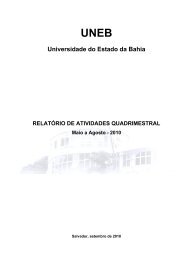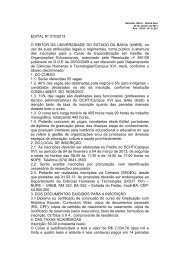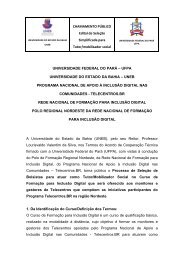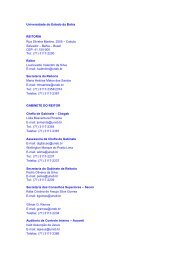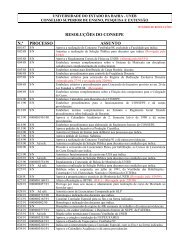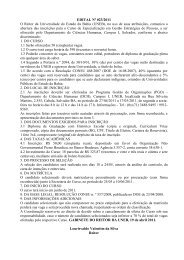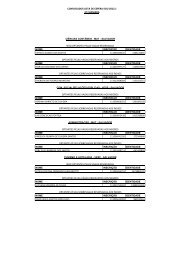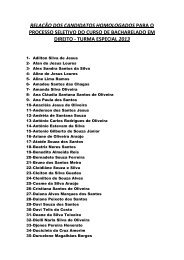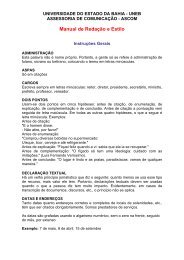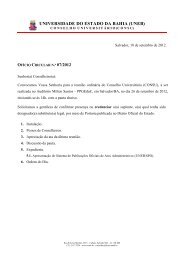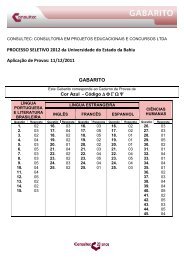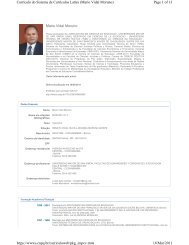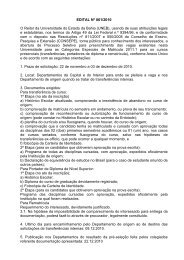Revista da FAEEBA Educação e Contemporaneidade - Uneb
Revista da FAEEBA Educação e Contemporaneidade - Uneb
Revista da FAEEBA Educação e Contemporaneidade - Uneb
Create successful ePaper yourself
Turn your PDF publications into a flip-book with our unique Google optimized e-Paper software.
Se der a gente brinca: crenças <strong>da</strong>s professoras sobre ludici<strong>da</strong>de e ativi<strong>da</strong>des lúdicas<br />
56<br />
qualitative research whose methodology is based upon observation, interview<br />
and (self)-biography as investigative tools. The basic interrogation which guided<br />
this work was: what beliefs did teachers elaborated about ludicity and playful<br />
activities? It was also observed that the integration of the playful dimension in<br />
the school requires to deal with several convictions about the school foun<strong>da</strong>tion,<br />
the role played by the teachers and students, which somehow justifies the<br />
resistance of such professionals to a playful work. Because of this resistance,<br />
the role of ludicity and playful activities is downplayed. The fact that the<br />
researched school focuses on the education of children is also an aspect that<br />
limits or undermines a <strong>da</strong>ily life based on playfulness in the educational space.<br />
In the study of teachers’ beliefs, this paper contributes adding three conviction<br />
related features: the personal and professional aspects interrelation, its<br />
generalization feature and its influence on the creation of stereotypes.<br />
Keywords: Playfulness – Playful activities – Beliefs<br />
Esse artigo, fruto <strong>da</strong> pesquisa que realizei<br />
no período dedicado ao Mestrado em <strong>Educação</strong>,<br />
objetiva apresentar as crenças detecta<strong>da</strong>s<br />
em quatro professoras <strong>da</strong>s séries iniciais do<br />
Ensino Fun<strong>da</strong>mental público, do Município de<br />
Salvador-BA, no ano de 2004, sobre a ludici<strong>da</strong>de<br />
e as ativi<strong>da</strong>des lúdicas. A abor<strong>da</strong>gem<br />
metodológica para o desenvolvimento deste trabalho<br />
se embasou nos pressupostos <strong>da</strong> pesquisa<br />
qualitativa, sendo a observação, a entrevista<br />
semi-estrutura<strong>da</strong> e a autobiografia os três instrumentos<br />
investigativos utilizados. A escola<br />
pesquisa<strong>da</strong> localiza-se em um bairro popular,<br />
sendo sua população eminentemente de negros.<br />
No que se refere às professoras que contribuíram<br />
para a feitura desta pesquisa, os nomes<br />
fictícios adotados são: Cândi<strong>da</strong>, Margari<strong>da</strong>,<br />
Mariazinha e Teresinha.<br />
Diante <strong>da</strong> compreensão de que as crenças<br />
compõem um sistema que se organiza de forma<br />
a sustentar e justificar as demais, tornou-se<br />
também necessário, para uma melhor compreensão<br />
<strong>da</strong> temática dessa pesquisa, analisar algumas<br />
convicções sobre educação, escola,<br />
aluno e trabalho docente, de forma a compreender<br />
onde as convicções sobre ludici<strong>da</strong>de e<br />
ativi<strong>da</strong>des lúdicas se alicerçam. Dessa forma,<br />
esse trabalho apresentará as crenças presentes<br />
em ca<strong>da</strong> um desses blocos, discutindo as<br />
mais fecun<strong>da</strong>s para a compreensão desse estudo.<br />
No entanto, antes <strong>da</strong> apresentação <strong>da</strong>s<br />
crenças, torna-se importante discutir três conceitos-chave<br />
que nortearão esse trabalho: ludici<strong>da</strong>de,<br />
ativi<strong>da</strong>des lúdicas e crenças.<br />
1.ESCLARECIMENTOS CONCEITUAIS<br />
PARA A COMPREENSÃO DESSE ES-<br />
TUDO<br />
O primeiro conceito que trago é o de ludici<strong>da</strong>de,<br />
que entendo como fenômeno subjetivo<br />
que possibilita ao indivíduo se sentir inteiro,<br />
sem divisão entre o pensamento, a emoção e<br />
a ação. Essa plenitude é decorrente <strong>da</strong> absorção,<br />
<strong>da</strong> entrega, <strong>da</strong> liber<strong>da</strong>de associa<strong>da</strong> ao<br />
comprometimento do indivíduo, do significado<br />
que possui para ele a ativi<strong>da</strong>de que está se<br />
propondo a realizar. Assim, a ludici<strong>da</strong>de se<br />
caracteriza como uma atitude <strong>da</strong>s pessoas e<br />
não inerente a algo ou alguém. Também não<br />
poderá ocorrer,se mediante atitudes impositivas,<br />
rígi<strong>da</strong>s, que negam a espontanei<strong>da</strong>de, e o<br />
respeito às diferenças. Essa definição encontra-se<br />
embasa<strong>da</strong> nas discussões e estudos realizados<br />
pelos membros do GEPEL, a partir<br />
do trabalho de Cipriano Luckesi (2000; 2002).<br />
O autor define a ludici<strong>da</strong>de a partir de um<br />
ponto de vista interno e integral do sujeito. Essa<br />
plenitude poderá ser vivencia<strong>da</strong> com a presença<br />
<strong>da</strong> espontanei<strong>da</strong>de, <strong>da</strong> flexibili<strong>da</strong>de e, nesse<br />
sentido, proporciona prazer e significado<br />
<strong>Revista</strong> <strong>da</strong> <strong>FAEEBA</strong> – <strong>Educação</strong> e Contemporanei<strong>da</strong>de, Salvador, v. 15, n. 25, p. 55-77, jan./jun., 2006



